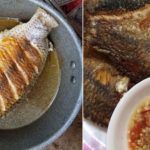Filleting fish:
Frying fish according to the instructions below will not result in burnt or broken fish.
– Choose fresh, thick-bodied tilapia. Ask the fish seller to scale and remove the black part inside the fish and also clean it.
– If you don’t like to eat fillet, you can leave the fish whole.
– Wash the fish with ginger and salt and rinse it with water.
– Use a towel or paper to dry the fish and cut it into thin slices, about 2cm thick.

– Pour cooking oil into a hot pan, then add 1 teaspoon of rice flour or wheat flour to the pan and stir well. Then, fry each slice of fish on medium heat. When the fish is fried to a golden color, flip the fish and fry until the other side is golden, then transfer it to a plate.
The same method applies to frying a whole fish.

Note:
– Only put the fish into the hot oil.
– Do not flip the fish before it turns golden to avoid breaking it.
– Do not cut the fish slices too thin or fry the fish too golden, as it will make the natural sweetness of the fish disappear.
Fried fish is not afraid of breaking, it is crispy on the outside and the meat inside remains sweet without being too dry. No need for any seasoning and the fish is not fishy at all.
Some ways to make fried fish crispier:
Rub ginger on the bottom of the pan
Before frying the fish, rub a slice of ginger all over the surface of the pan. This is one of the effective methods to prevent sticking when frying fish, and it even works when frying other foods.
Use salt
When adding oil to the pan, add a few grains of salt and continue to heat the pan and fry the fish as usual. The oil will no longer splatter. In addition, salt helps firm up the fish and make it easier to flip. Before frying the fish, soak it in diluted salt water for about 10-15 minutes. Then, drain or dry the fish before frying.
Apply egg white on the fish
Before frying the fish, if you apply egg white all over the surface of the fish, it will make the fish delicious, prevent sticking, and make the skin crispy.



































